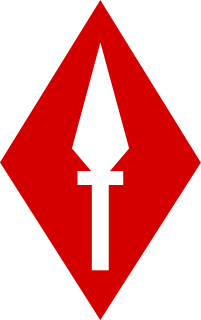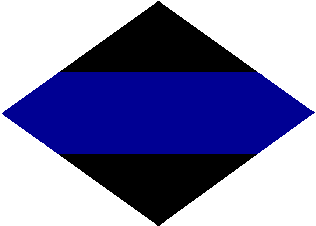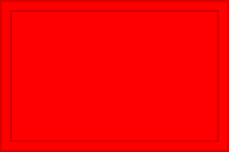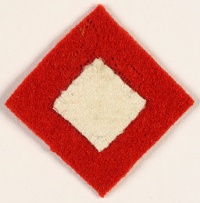A division is a large military unit or formation, usually consisting of between 6,000 and 25,000 soldiers.

I Corps was an army corps in existence as an active formation in the British Army for most of the 80 years from its creation in the First World War until the end of the Cold War, longer than any other corps. It had a short-lived precursor during the Waterloo Campaign.

The 2nd Canadian Armoured Brigade was an armoured brigade of the Canadian Army that saw active service during World War II. The brigade was composed of the 6th, 10th and 27th Canadian Armoured regiments and saw service in northwest Europe, landing in Normandy on D-Day and remaining in combat up to Victory in Europe Day.

The 3rd Division is a regular army division of the British Army. It was created in 1809 by Arthur Wellesley, 1st Duke of Wellington, as part of the Anglo-Portuguese Army, for service in the Peninsular War, and was known as the Fighting 3rd under Sir Thomas Picton during the Napoleonic Wars. The division fought at the Battle of Waterloo, as well as during the Crimean War and the Second Boer War. As a result of bitter fighting in 1916, during the First World War, the division became referred to as the 3rd (Iron) Division, or the Iron Division or Ironsides. During the Second World War, the division fought in the Battle of France including a rearguard action during the Dunkirk Evacuation, and played a prominent role in the D-Day landings of 6 June 1944. The division was to have been part of a proposed Commonwealth Corps, formed for a planned invasion of Japan in 1945–46, and later served in the British Mandate of Palestine. During the Second World War, the insignia became the "pattern of three" — a black triangle trisected by an inverted red triangle, created by Bernard Montgomery to instil pride in his troops.

The 1st Canadian Division is an operational command and control formation of the Canadian Joint Operations Command, based at CFB Kingston.

The 3rd Canadian Division is a formation of the Canadian Army responsible for the command and mobilization of all army units in the provinces of Manitoba, Saskatchewan, Alberta and British Columbia, as well as all units extending westwards from the city of Thunder Bay.

The 4th Canadian Division is a formation of the Canadian Army. The division was first created as a formation of the Canadian Corps during the First World War. During the Second World War the division was reactivated as the 4th Canadian Infantry Division in 1941 and then converted to armour and redesignated as the 4th Canadian (Armoured) Division. Beginning in 1916 the division adopted a distinctive green-coloured formation patch as its insignia. In 2013 it was announced that Land Force Central Area would be redesignated 4th Canadian Division. It is currently responsible for Canadian Army operations in the Canadian province of Ontario and is headquartered at Denison Armoury in Toronto.

The 5th Canadian Division is a formation of the Canadian Army responsible for the command and mobilization of most army units in the provinces of New Brunswick, Nova Scotia, Prince Edward Island and Newfoundland and Labrador; as well as some units in Kingston, Ontario. The division is recognized by the distinctive maroon patch worn on the sleeve of its soldiers.

The South Alberta Light Horse (SALH) is a Canadian Army armoured reconnaissance regiment of the Canadian Army Reserve. It traces its complicated lineage to the Rocky Mountain Rangers, and claims its direct ancestry to the 15th Light Horse, along with various other Alberta based cavalry units. The "Light Horse" designation comes from its light cavalry and mounted infantry origins.

The 11th Armoured Division was an armoured division of the British Army which was created in March 1941 during the Second World War. The division was formed in response to the unanticipated success of the German panzer divisions. The 11th Armoured was responsible for several major victories in the Battle of Normandy from in the summer of 1944, shortly after the D-Day landings of 6 June 1944, and it participated in the rapid advance across France, Belgium, and the Netherlands and, later, the Rhine crossing in March 1945, and later invaded Germany. It was disbanded in January 1946 and reformed towards the end of 1950. In 1956, it was converted into the 4th Infantry Division.

The 42nd Armoured Division was an armoured division of the British Army raised during the Second World War.

The Royal Canadian Army Service Corps (RCASC) was an administrative and transport corps of the Canadian Army. The Canadian Army Service Corps was established in the Non-Permanent Active Militia in 1901 and in the Permanent Active Militia in 1903. The Canadian Permanent Army Service Corps was redesignated The Royal Canadian Army Service Corps on 3 Nov 1919.

II Canadian Corps was a corps-level formation that, along with I (British) Corps and I Canadian Corps, comprised the First Canadian Army in Northwest Europe during World War II.
The 185th Infantry Brigade was an infantry brigade formation of the British Army raised during the Second World War that participated in the Normandy landings of 6 June 1944, fighting in the Normandy Campaign and the subsequent campaign in North-West Europe with the 3rd British Infantry Division.
The 33rd Armoured Brigade was an armoured brigade of the British Army that was active in northwestern Europe in the Second World War from June 1944 until May 1945 and from 1980 to 1992.

The Moro River Campaign order of battle is a listing of the significant formations that were involved in the fighting during the Moro River Campaign in December 1943, part of the Italian Campaign of World War II.

The First Canadian Army was a field army and a formation of the Canadian Army in World War II in which most Canadian elements serving in Northwest Europe were assigned. It served on the Western Front from July 1944 until May 1945.
Formation signs at the division level were first introduced in the British Army in the First World War. They were intended (initially) as a security measure to avoid displaying the division's designation in the clear. They were used on vehicles, sign posts and notice boards and were increasingly, but not universally, worn on uniform as the War progressed. Discontinued by the regular army after 1918, only a few Territorial divisions continued to wear them before 1939. Reintroduced officially in late 1940 in the Second World War, divisional formation signs were much more prevalent on uniforms and were taken up by many other formations, independent brigades, corps, armies, overseas and home commands, military districts and lines of communication areas. The sign could be based on many things, geometry, heraldry, regional or historical associations, a pun, the role of the division or a combination.